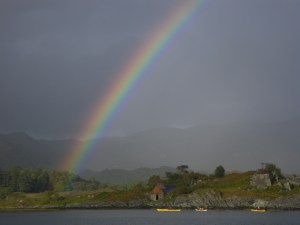Plantlife is 25 years old this year. On 11 March, we celebrated with an event at Stirling Castle where I cast my eyes forward, looking for the end of the rainbow…

To quote Iris Murdoch: ‘people from a planet without flowers would think we must be mad with joy the whole time to have such things about us.’ It is the beauty and diversity of Scotland’s flowers that get my team and I to work every morning and give us the impetus to keep going.
Over the last 25 years we’ve have had our successes and we’ve faced our challenges. Plants are still the wallflowers at the biodiversity ball. Today, while attention and fashion shifts from species and habitats work to healthy ecosystems and ecosystem services, we still have a big job to do. And we see that job as providing clarity on conservation and providing inspiration to keep going and try something new. If we cast our eyes forward, what is tomorrow’s colour for conservation?
It’s not all about being green …. It’s actually an entire rainbow.
Plant conservation is all about colour. Conserving the colour in our countryside is how we put it. This means managing the full diversity of amazing and unique habitats we have here in Scotland.
So what’s making us see red?
Homogenisation and monotony. Scotland has such a wide variety of habitats and species in it. Our geographic location and our geology have bequeathed us with colour. Our Important Plant Areas (IPAs) show what we have: over the next few years, we want to see out IPAs cherished and protected. And outside of them, we want to see our farmland managed with nature in mind. We want to see support for high Nature Value Farming and Forestry and we want to see land managers being paid to deliver the public goods, we and the rest of the public want to see – more biodiversity, more plants and fungi across the country. Let’s make managing for wild plants a normal part of everyday farming.
Orange is the colour of joy:
Over the next 2 years, we will be rolling out our new HLF supported Celtic rainforest project in the west coast IPA, concentrating on Argyll and with our outdoor education centre partners getting school children out into our Celtic rainforest, taking up our new John Muir Trust Celtic Rainforest Discovery Award and dragging their parents out too. Let’s ensure every child in Scotland gets to sniff moss, make nettle string and draw in fungus ink.
The shaft of yellow:
We’re looking for funding for a new project to bring the generations together to enjoy wild plants and fungi and to learn from each other. Our volunteer flora guardians are generally older people with a great and building font of knowledge. Our children are increasingly isolated from nature. We want to bring these two forces together to build intergenerational relationships that cherish plants and fungi together, that learn and know more about their local plants and fungi and that inspire others to act to find out more and help us work to conserve them. Including politicians. Our ray of sunshine is building confidence in identifying and using wild plants.
The blue skies of vision:
This is where IPAs come in again: they show our vision of what can be achieved. We’ve been providing advice on managing the plants in IPAs since 2008 and we are focussing on promoting with our partners the roll out of landscape scale advice and action in the west coast Atlantic woodland and the Caledonian pinewoods and others.
We can continue to underpin this with our species advisory service, getting staff out to provide advice, provide demonstration days so land managers can see what can be achieved, can network and learn from each other and from specialist experts we can bring in.
In the next 15 years, we would like to have rolled out our IPA programme further so that landscapes scale projects are successfully operating in 4 more IPAs, reconnecting fragmented habitats, supporting a high diversity of plants species, drawing wildlife and people and inspiring communities and individuals in those areas to get involved on our vision for flower and fungi rich places.
The purple haze of Holyrood:
We want all our politicians to be signed up as species champions and for them to be able to use their species in all their policy work, to nature proof every legislation decision that is made in Holyrood.
So where is the pot of gold at the end of the rainbow?
Our pot of gold is our support. Founder members, life members, partners, volunteers and supporters. Increasing support and increasing wider awareness of the importance of plants and fungi, ecologically as well as socially and economically, has 2 clear benefits:
It gives us more resources to do more stuff on the ground, working with others. AND it gives us more political weight. It is a numbers game at Holyrood – the more people we have behind us saying plants and fungi matter to them, the stronger our voice is at Holyrood.
We want to do more for plants and fungi in Scotland. With your support, we can build a stronger future, not just for plants and fungi but for everything that depends on them.
Very well put. I hope this message reaches as many people as possible to advance these fantastic projects.
LikeLike
good to know about all this
LikeLike